Management: This essay is meant to be less of a review and more of analysis of the show being examined. It contains plot spoilers for the Land of the Lustrous anime.
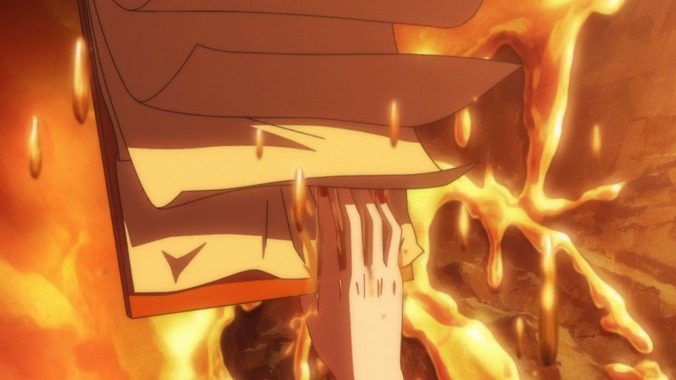
Iconography is a powerful tool in storytelling. The power of icons belies and transcends the descriptor of them as being mere assortments of organized lines, shapes, and maybe colors. Even if audiences don’t fully understand their cultural context, icons hold a power over a people who are even just passingly familiar with them. The more ancient and fundamental seeming these icons are in a given culture, the more power they have over shaping the expectations of audiences when consuming a work of fiction utilizing them. Like money, icons are a currency that those in the know conduct exchanges with, with the medium of exchange being knowledge instead of paper or metal. For instance, the knowledge of whether or not your friend likes certain anime without asking him can be ascertained from the Homura figurine he positions on his writing desk or the Rem plushie he keeps at his bedside. The knowledge of your friend’s interest in certain religions can be deduced without direct inquiry based on the crucifix on her wall or the buddha on her nightstand.
Many storytellers set up expectations based on how audiences understand these icons in the real world. Religious iconography, even without much knowledge of doctrine, possesses the cultural currency of something deep and profound. Land of the Lustrous and the Evangelion franchise contain copious amounts of this kind of iconography. While Evangelion doesn’t demonstrate any deep or profound understanding of the Christian symbolism it mucks around in, audiences are nevertheless drawn to it by the iconography’s intangible appeal. Land of the Lustrous goes further with its iconography, exhibiting a more-than-passing understanding of the Buddhist symbolism it sculpts its characters out with. Most people watching Land of the Lustrous will at least recognize that some of its iconography is Buddhist in origin. Those with passing familiarity with Buddhism may find themselves attracted to these icons because of their pop culture associations with deep and profound powers or knowledge. Those with more educated backgrounds in the Buddhist religion may may also expect the themes of the story to unfold in ways that reflect a Buddhist worldview.
To be clear, I can’t ultimately predict where Land of the Lustrous will take its audiences narratively. I can only speculate on where the story might vaguely lead to based on my prior knowledge of Japanese Buddhism. However, I do think that Land of the Lustrous is far more enriching a watch with an understanding of its cultural-religious context. The show deliberately uses the iconography to reference and invoke Japanese Buddhist concepts and values. These concepts and values touch on the very existentialist concerns that the show invokes and ponders throughout its run-time.
Existentialist and Buddhist Concerns

As the mythos goes, the Buddhist worldview is narratively represented in the Buddha’s struggles to understand why suffering exists and persists, struggles which occupy common ground with existentialist concerns. A young and sheltered prince steals himself from the confines of his family’s palace and father’s eye. Outside, he witnesses the disheartening examples of sickness, old age, and death. These tragic phenomena happen to people naturally and ubiquitously. They are the products of change, he realizes. Resisting the losses that these changes provoke is the root of all suffering, he realizes. Shortly after, the prince gives up his creature comforts and claims to the throne. The prince embarked on a spiritual quest to discover a solution to a vexing problem. The former prince would spend the remainder of his life trying to discover why people had to suffer, and if there was a way for people to overcome suffering. In his enlightenment, he came to the following conclusion: whether it be their health, their youth, or their lives, people suffer because they believe they have something important in their lives to lose. If people refrained from attaching themselves obsessively to anything or anyone, accepting that change and coming to peace with the losses that inevitably result from it, then loss would altogether cease to sting. Suffering could be averted.
Cosmologically in Buddhism, suffering is the repetition of death and life embodied in the reincarnation cycle (otherwise known as samsara). People die in suffering, and in their suffering, they are reborn again into lives of more suffering. The cycle is a repetition of consistent agonies that — if only we remembered our past lives or understood the bigger picture without the benefit of enlightenment — would render all our existences as a repetition of meaningless agonies. The cycle is fueled by the suffering incurred from the experience of losing what people are attached to. Transcending the cycle and averting suffering is what Buddhism seeks to help people realize. In part, enlightenment, the moment of transcendence, is achieved by coming to peace with change and loss. In Buddhism, when loved ones die, the living are encouraged to respond to the loss not with agony about why they had to leave them behind, but with hope that they will reincarnate into something greater or transcend the cycle altogether.
Buddhism in Japan
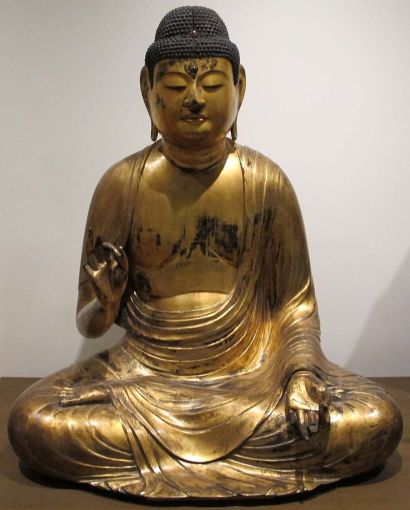
Ever since it was imported from the Asian mainland through the Korean peninsula, Buddhism has had a significant impact on Japanese culture. For instance, cremation of the dead in Japan is informed by Buddhist belief. Practical considerations of limited land space partly explain why the Japanese tend to burn their dead instead of bury them. However, Buddhist admonishments against attachment also contribute an explanation to why the Japanese are comfortable with turning the visages of their loved ones into indiscriminate heaps of ash. Funerals in Japan today tend to be conducted under the solemn umbrella of Buddhist rites. Death in Japan today is widely considered the spiritual purview of Buddhism. Historically speaking, Buddhism enjoyed enormous of popularity among the Japanese common folk during periods of tribulation and instability in the country. Those periods were marked by war and famine, and many Japanese peasants during those times turned to Buddhism for relief from their precarious existences. For the Japanese, Buddhism was a means to prepare for any number of debilitating losses, death among them, that could encroach into their lives at any day.
Numerous varieties of Buddhism are practiced in Japan. The Japanese are generally eclectic about their spiritual beliefs, both within and outside of Buddhism. However, by far the most widely practiced form of Buddhism in that country is Pure Land. Pure Land Buddhism is a denomination of Buddhism that stems from the Mahayana branch of the Buddhist religion’s three main schools (the other two being Theravada and Vajrayana/Esoteric). The Mahayana branch goes farther in its precepts of enlightenment than the Theravada branch — which mainly emphasizes the wisdom of the Buddha’s teachings — by also stressing the intercessory powers of Buddhist entities to liberate existences. More than any other form of Buddhism in Japan during times of tribulation and instability, Pure Land Buddhism best suited the needs of commoners seeking relief from their precarious existences. Unlike the Vajrayana/Esoteric branch, it doesn’t require its faithful to become especially well-educated in Buddhist canon. Nor does its force its faithful to sacrifice inordinate amounts of time on Buddhist rituals that they they could otherwise spend eking out a living.
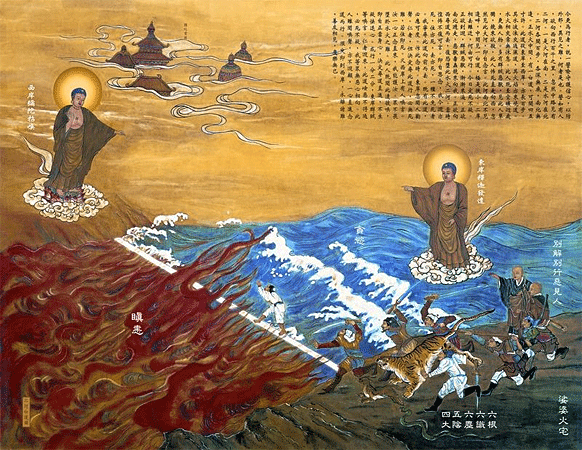
One of the defining features of Pure Land Buddhism is the concept of the Pure Land (also known as the Western Paradise). The Pure Land is a plane of existence can be seen as a rough mix of heaven and purgatory in Christianity. Suffering characterizes existence far less when people are reborn into the Pure Land. However, people reborn there aren’t yet people who have transcended the reincarnation cycle. They still experience some suffering in the Pure Land as they await the moment where they can finally transcend the cycle altogether. Because the Pure Land is considered to be a higher plane of life than any one existence lived out on Earth, the Japanese have associated the Pure Land with celestial bodies.

One of the celestial bodies often referenced by the Japanese is the Moon, and the celestial beings that supposedly reside on it play an important role in Buddhist-imagined re-tellings of classic Japanese folk tales. For instance, in The Tale of the Bamboo Cutter, the young female protagonist is taken away from Earth to the Moon by celestial beings, which have been re-imagined in some versions as Buddhist entities (such as in The Tale of Princess Kaguya film). Depending on the story iteration, she is taken away because either her original nature as a Moon person is alien to the Earth or her more perfect origins as a celestial inhabitant is too perfect to remain residing on plane defined by great suffering. Upon being retrieved, she loses all memory of the life she once knew, including all its sadness and joys.
Buddhist Influences in Land of the Lustrous
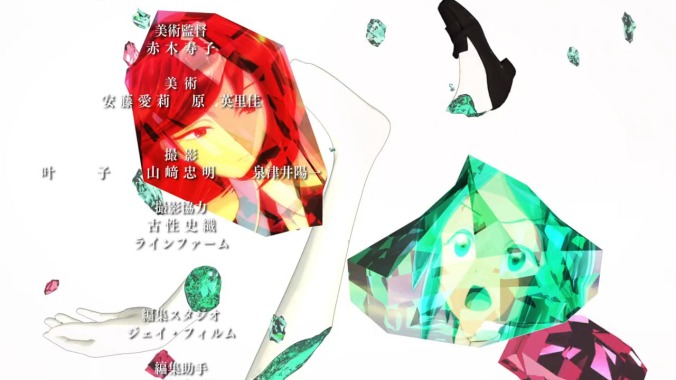
The Lustrous are an a sentient and intelligent race of humanoid gemstones. Gemstones are a type of rock or mineral. Many of the religious traditions that spawned out of India incorporate some form of the reincarnation cycle into their belief systems (i.e. Jainism, Sikhism, Hinduism, Buddhism, etc.). Even as other Buddhist beliefs were altered or discarded to adapt to local traditions in in its missionary spread beyond India, the cycle survived wherever it set roots as a key pillar of Buddhist cosmology. Land of the Lustrous references the reincarnation cycle when Diamond (Dia for short) mistakenly believes that Phosphophyllite (Phos for short) was reborn as a small slug after being seemingly annihilated out of existence by the digestive acids of a giant snail. Dia muses whether Phos reincarnated as an attempt at undergoing change for the better.
The reincarnation religions developed orders of hierarchy that designate superior and inferior relationships of relative status between the various forms and planes of existence, such as the Earth and the Moon and humans and minerals. Minerals have been traditionally classified as being on the lower end of this hierarchy. Human beings have been traditionally classified as being on the higher end. Despite minerals being ranked lower than human beings, the Lustrous possess many of the positive qualities associated with humanity, while lacking many of humanity’s negative traits. The Lustrous are sentient, intelligent, and have the ability to reason. Moreover, the Lustrous don’t fall ill, grow weak with age, or die.
The Lustrous don’t contend with with the negative effects of change in the ways humans have to. Does this suggest anything about the nature of the Lustrous relative to the nature of humanity? On the one hand, the Lustrous are exempt from certain major forms of detrimental change that humans inevitably have to endure. On the other hand, the Lustrous are minerals, and minerals have traditionally been considered as a lower form of existence than humanity. The suggestion is mixed, an ambivalent notion that’s further complicated when it’s suggested that the Lustrous are descended from human beings. It seems more reasonable to conclude, then, that the Lustrous shouldn’t be seen as ranking any better or worse than their human ancestors. The Lustrous might not change for the worse in the exact ways that humans do (i.e. with sickness, old age, and death). However, they are affected by loss all the same, loss that can be searing. They suffer, just like us, because they lose things and people that they are attached to. In the case of death, if you’re willing to be flexible with its definition, the abductions of the Lustrous by the Lunarians constitute its own consequence of permanent separation. And when it happens to loved ones, those left behind suffer in these losses’ wakes.
The theme of loss and suffering in Land of the Lustrous is reinforced by (1) the iconography utilized, (2) the conflicts embroiled, and (3) the behaviors engaged in by the Lustrous and others.
(1) Iconography Utilized

Phos, Cinnabar, Dia, and most other members of the Lustrous wear the black-and-formal collar-and-tie attire that is customarily worn by people attending a funeral.
Kongo-sensei is appropriately attired as the Japanese Buddhist monk who officiates the rites of a Japanese Buddhist funeral.

The Lunarians who periodically strike against and steal away members of the Lustrous have character designs that are based off the iconography of significant entities in the Buddhist canon. The most numerous of the Lunarians are based off the appearance of apsaras. Apsaras are cloud and water spirits that are prominent in Buddhist as well as Hindu artwork. They are typically depicted with lithe-looking and lightly-clothed bodies that sway in rhythm to dance and music. In the context of Japanese Buddhism, they serve and function as a rough equivalent in Christianity to angels, assistants to God and the saints.

Then there are the Lunarians who look like bodhisattva, themselves the rough Japanese Buddhist equivalent in service and function to one party angels serve: Christian saints. Depicted in the center of a Lunarian grouping, they tend to be more heavily embellished with raiment and jewelry. Whereas buddhas have already transcended the cycle of reincarnation (buddhas in general as opposed to the Buddha specifically), boddhisattva (of the Mahayana branch that is popular in Japan) postpone their transcendence from the cycle so that they can intercede as guides to enlightenment for those who still struggle with attachments, loss, and suffering.


Cutting open the bodhisattva Lunarians reveals hollow patterning reminiscent of lotus taproots. The lotus flower that these roots support is a symbol of enlightenment in Buddhism. The vibrant petals of the lotus flower bloom in a natural habitat characterized by murky and muddy freshwater. Studying lotus flowers is considered an exercise of contemplation in Buddhism, a beautiful truth to be realized in a plane of obfuscating suffering.

Speaking of contemplation in Buddhism, the Japanese Buddhist art of Kintsuji is an exercise in demonstrating and coming to terms with the truth of change, at once both detrimental and beautiful. Cracked pottery is pieced together using binding agents of lacquer combined with precious metals such as gold or platinum. The result is repaired pottery lined with uneven metallic veins. The iconography is invoked in Phos’ transformation into a warrior, with the incorporation of gold and platinum alloys to replace her missing limbs and the shattering and absconding of Antarcticite by a Lunarian ambush. Gold leaf is also often used in Pure Land Buddhist artwork, as the visage of the Pure Land is often to be one that’s golden studded with gems.


While it would be presumptuous to assume that the Moon functions exactly like the Buddhist Pure Land — like how it would be presumptuous to presume the origins of the Holy Grail in the Fate/ franchise based solely on the real life legend of the Holy Grail — the iconography of the imagery here is deliberately being leveraged for all its cultural currency to inform the expectations of audiences in the know. The inclusion of the Holy Grail in the Fate franchise is meant to invoke a chapter in the legend of King Arthur and twisted irony. The Moon and the Lunarians who make it their home is meant to invoke the Pure Land and existentialism-themed tragedy.
(2) Conflicts Embroiled

The Lustrous and the Lunarians are engaged a conflict spanning millennia. The Lustrous defend against the periodic aggressions of the Lunarians, with the former always forced to fight on the terms of the latter. The Lunarians constantly attack the Lustrous, trying to force the change of loss through abduction. The Lustrous can only resist the changes being imposed upon them, with failures represented through their lost numbers. This conflict seems to have no end in sight, and are the cause of great suffering for the survivors.
The main objective of the Lustrous camp is to resist being abducted by the Lunarian one. The side objective of the Lustrous is to retrieve and rescue any pieces of their kind that were previously abducted and subsequently cannibalized by the Lunarians into weapons. The alternate objective of the Lustrous taking the fight to the Lunarians and rescuing their kind from their home turf is impossible (as of the time of this essay’s writing about the show). The former are based on Earth and have no way travel to the latter’s home turf on the Moon by their own agency, let alone return back.
The exact objectives of the Lunarians (at the time of this essay’s publication) is unknown and can only be guessed at. While it’s too early to assume anything definitive about their place in the story based off of real-life Buddhist resemblances, the Buddhist iconography of the fictional Lunarians can still help inform the expectations of the audience as to their purpose in the narrative — if not worldbuilding-wise, then at least thematically. Bodhisattva-reminiscent entities descend from the heavens with apsara-looking attendants (Tennin in Japanese) to take gemstone people away to the celestial body-attributed and gemstone-studded Pure Land. It appears that the Lunarians are here to save the Lustrous from suffering. While that might not necessarily be the case to the letter, as Ventricosus casts doubt on the benignity of the Lunarians while discussing them with Phos, it does inform the inner conflict that defines Cinnabar’s role in the story.
(3) Conflicts Engaged In: Cinnabar

One of the first belligerent encounters presented in the show between the Lustrous and the Lunarians is the one where Cinnabar fights off a Lunarian onslaught and saves Phos. In the aftermath of the encounter, Cinnabar confesses to Phos of wanting to be abducted by the Lunarians. Cinnabar lives an existence of suffering because of two apparent reasons: (1) the desire to be closer to others and (2) the necessity of having to keep others away from them. Cinnabar’s passive secretion of toxic mercury — as is natural of her mineral nature — poses a threat to the welfare of the other Lustrous. Cinnabar’s decision to push the other Lustrous away, combined with their attachment to be with the other Lustrous, leaves them lonely and self-loathing.
The Tale of the Bamboo Cutter features a young girl being taken away by celestial beings from the Earth to the Moon because she doesn’t belong there or suffers remaining on Earth. Land of the Lustrous’ Cinnabar wants to be taken away by the Lunarians from the Earth to the Moon because they suffer greatly and feel alienated living on Earth. In their desperation, Cinnabar sees their abduction by the Lunarians as a opportunity to be liberated and saved from their suffering — if not to a plane of happiness, then at least a plane of nothingness.
Abduction is the equivalent of death for the Lustrous — if we’re flexible enough to interpret death to mean permanent separation, broadly speaking. Despite being different from humans in many ways, their similarities to humans in all the important ones (especially where the experience of loss is concerned) still allow the Lustrous to resonate with audiences in relatable facets. Ventricosus explains to Phos what death means to her, stating that death is what gives life meaning. The significance of losing someone we hold dear, whether it be ourselves or others, is great enough for death be a special event for us in the sea of change that is our lives. The suffering that could arise from death can have an dramatic effect on a person’s future beliefs and behaviors, as was the case with Phos.
(3) Conflicts Engaged In: Phos

Phos is depicted initially as being lazy, carefree, and unable to focus on any one task before becoming distracted by something else or giving up entirely. Despite 300+ years of existence behind them, Phos drifts through life insecure because of their seeming lack of utility brought about by a fragile constitution. That insecurity and fragility contributes to their quandary for purpose. Phos is haunted by the inability to contribute meaningfully to the Lustrous’ fight against the Lunarians. Because the other Lustrous could do those tasks better than Phos could and could pick up their slack anyway, Phos lacked the motivation to train harder on the tasks they were assigned to in order to become useful. Even with the task to compile an encyclopedia, Phos considered the task of recording facts about the world pointless in the context of the Lustrous-Lunarian conflict, just busywork to make their pointless life appear less pointless.
Then Phos met Cinnabar. Cinnabar saved Phos. Phos connected with Cinnabar over their shared problems, learned something intimate about the latter, and perceived in Cinnabar a cry for help. The former pledged to help Cinnabar, independent of any direct requests from the latter, and resolved to change for that reason. Phos became attached to Cinnabar. Phos become willing to degrade themselves for Cinnabar if it meant not losing them. From that attachment spawned major changes in Phos that, while leading them into becoming the warrior that they always yearned to become, cost them dearly in many other ways. Phos lost their legs, their arms, and then a friend that they also became dearly attached to.


Their new haircut resembled the lost Antarcticite, their friend.

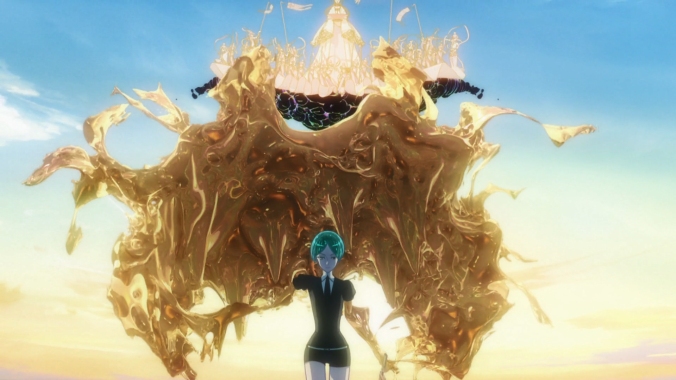
Their new powers resembled Cinnabar’s in form.
These character designs, these new abilities are the scars of trauma, the physical reminders of the agonizing suffering that Phos’ endured in order to change for their loved ones, to make sure that they wouldn’t lose anymore, despite the fact they lost one and fear losing another. Were these changes for the better? For Phos’ power levels, they most certainly were. They are certainly more knowledgeable now too. However, a Buddhist perspective suggests that any road that leads to more suffering is a dangerous path to travel.
Conclusion

To reiterate, I would be careful about using the values suggested in the Buddhist iconography to plot out where Land of the Lustrous will take its story. Much of the iconography in the show is being incorporated in ways ironic to what Buddhism stands for. For instance, Phos’ transformation into a warrior is portrayed as an awakening, complete with the image of a golden lotus blooming behind them. However, enlightenment is supposed to lead to the complete secession of suffering, not the acute experience of it. But at the same time, the characters’ suffering is very much in line with Buddhist teachings regarding it. Phos attempts to resist detrimental changes to their attachments — attempts to prevent losing their loved ones. They suffer mightily as a result.
Either way, it’s fascinating to see how this work of fiction, like Japanese fairy tales and noh plays, incorporate Buddhism to impart lessons to its audiences. Land of the Lustrous has the potential to become a contemporary Buddhist classic.
Management: Other insightful articles on Land of the Lustrous by other people include ajthefourth’s article on the show’s flowers, Blue Variance’s article on show’s butterflies, and iblessall’s article on the show’s… headpats (and hands).
Thank you so much for sharing your thoughts on Buddhism and Land of the Lustrous. I’ve been enjoying the show so much this past season and wanted to read some opinions on the religious imagery since I have almost no understanding of Buddhist principles.
It did strike me that the Gems’ repeated shattering and mending were in their form a kind of little death and rebirth. Of them all, Phos has likely experienced the most “rebirths” thanks to the low hardness level. I thought it fitting that of all the Gems, Phos seemed to trigger guaranteed arrivals by the Lunarians. It’s like they want to save Phos most of all from the cycle of suffering.
Thanks for commenting. I’ve read ahead enough in the manga to have some idea as to why things are the way they are between the Lunarians and the Lustrous. I won’t go spoiling that, but you did bring up an interesting point on shattering and mending.
Thanks for the article! Your essays are always a joy to read and this one is as well. I learned a lot about Pure Land Buddhism from this article and I’m grateful that I’ll be able to better understand the show’s buddhist influences and icons.
also, just some typos I noticed:
“Many storytellers to set up expectations based on how audiences understand these icons in the real world. ” (to)
and
“Abduction is the equivalent of death for the Lustrous, that is if we we’re flexible enough to interpret death to broadly mean permanent separation.” (we we’re)
Glad you were able to learn something, and thanks for pointing out those typos. The drawbacks of having to rely on yourself as an editor: you get used to talking to yourself enough that you glance over mistakes that aren’t auto-corrected as you think.
Slight Spoilers:
Good stuff here, a nice overview of the Buddhist influences that are clear in the show, there are other less obvious things such as in episode 11 I noticed Sensei was in meditation and his Mudra seemed to resemble the Dhyana Mudra however, instead of the right hand being cupped upon the left, the hands are symmetrical and the thumbs aren’t even touching, which is an interesting use of incorrect iconography to emphasize a point I’m told will become apparent later on.
A lot of the best Buddhist parallels are relative to the dissonance between Sensei and the other gems in fact, there’s a lot you could say regarding the Gem’s general ‘Buddhist Maturity’ (seeing as they all seem to be stuck in ‘Dukkha’ due to their lack of understanding or desire to understand) you could say in comparison to Sensei, and the parallels to the setting with the Sukhavati, with the idea that being taken by the Lunarians is the cessation of all suffering or Magga and the idea that the gems surrender their faith to Sensei’s version of things, akin to Amitabha and this being framed as a bad or at least apprehensive thing in the later episodes comes across to me as a critique to Pure Land.
Thanks for the comment. I tried to avoid the rabbit hole for reader accessibility’s sake by watching talking about the most obvious Buddhist iconography and concepts that the show was leveraging (notice that I avoided using too many religiously jargon-y terms like Dukkha and Samsara). I neglected to pay attention to Kengo’s mudra though, so I’ll make sure to scrutinize his hands more closely in the future.
I will reiterate that many of the Buddhist icons and concepts being utilized by the show are being used rather ironically. Just keep that in mind if you want to read the manga (I have).
Pingback: Fall 2017 Season Wrap: Juni Taisen, Land of the Lustrous, & Food Wars! – Anime B&B
Pingback: Flower language in Land of the Lustrous | atelier emily
Pingback: X days #10: Too many Bodhisattvas | HEARTS OF FURIOUS FANCIES
Pingback: Otaku Links: New year, new links
Pingback: Land of the Lustrous: Mine Eyes Have Seen Much | therefore it is
Finally a good review with backing that isnt personal feelings. All I hear is transexual comments and skin deep understanding of asian culture and religion. This is awesome. More please.
Pingback: Identity Genderless and Buddhist Transcendence in Land of the Lustrous | therefore it is
Thanks for this primer on the Buddhist imagery! I recognized the lunarians as being similar to the beings who returned Kaguya-hime to the moon but didn’t really know what it meant. I liked seeing the context behind other details like the lotus flower that appears out of gold. (On that topic, does anyone know what the box that trapped Phos was? For some reason it looked like a computer chip to me…)
One thing I felt while watching the show was that Phos becomes stronger because they care for other beings. Each of the changes comes out of them trying to help someone. I like that there is nuance in the show’s portrayal of attachment and detachment, where the choice between the two is not obvious.
Thanks for the comment! Glad you got something out of my essay.
I’m not entirely sure if the box was a reference to anything, to be honest.
Pingback: Midweek Links: Oregon Anime, Lustrous Buddhist Symbolism, Dolezal Documentary – MDMRN